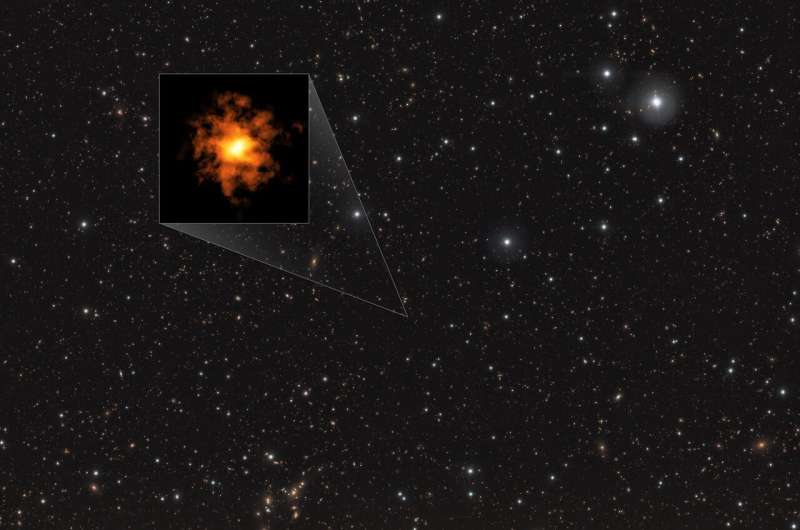Researchers have discovered the most distant Milky-Way-like galaxy yet observed. Dubbed REBELS-25, this disk galaxy seems as orderly as present-day galaxies, but we see it as it was when the universe was only 700 million years old.
This is surprising since, according to our current understanding of galaxy formation, such early galaxies are expected to appear more chaotic. The rotation and structure of REBELS-25 were revealed using the Atacama Large Millimeter/submillimeter Array (ALMA), in which the European Southern Observatory (ESO) is a partner.
The galaxies we see today have come a long way from their chaotic, clumpy counterparts that astronomers typically observe in the early universe. “According to our understanding of galaxy formation, we expect most early galaxies to be small and messy looking,” says Jacqueline Hodge, an astronomer at Leiden University, the Netherlands, and co-author of the study.
These messy, early galaxies merge with each other and then evolve into smoother shapes at an incredibly slow pace. Current theories suggest that, for a galaxy to be as orderly as our own Milky Way—a rotating disk with tidy structures like spiral arms—billions of years of evolution must have elapsed. The detection of REBELS-25, however, challenges that timescale.
In the study “REBELS-25: Discovery of a dynamically cold disc galaxy at z = 7.31,” accepted for publication in Monthly Notices of the Royal Astronomical Society, astronomers found REBELS-25 to be the most distant strongly rotating disk galaxy ever discovered. The light reaching us from this galaxy was emitted when the universe was only 700 million years old—a mere five percent of its current age (13.8 billion)—making REBELS-25’s orderly rotation unexpected. The findings are available on the arXiv preprint server.
“Seeing a galaxy with such similarities to our own Milky Way, that is strongly rotation-dominated, challenges our understanding of how quickly galaxies in the early universe evolve into the orderly galaxies of today’s cosmos,” says Lucie Rowland, a doctoral student at Leiden University and first author of the study.
REBELS-25 was initially detected in previous observations by the same team, also conducted with ALMA, which is located in Chile’s Atacama Desert. At the time, it was an exciting discovery, showing hints of rotation, but the resolution of the data was not fine enough to be sure. To properly discern the structure and motion of the galaxy, the team performed follow-up observations with ALMA at a higher resolution, which confirmed its record-breaking nature.
“ALMA is the only telescope in existence with the sensitivity and resolution to achieve this,” says Renske Smit, a researcher at Liverpool John Moores University in the UK and also a co-author of the study.
Surprisingly, the data also hinted at more developed features similar to those of the Milky Way, like a central elongated bar, and even spiral arms, although more observations will be needed to confirm this.
“Finding further evidence of more evolved structures would be an exciting discovery, as it would be the most distant galaxy with such structures observed to date,” says Rowland.
These future observations of REBELS-25, alongside other discoveries of early rotating galaxies, will potentially transform our understanding of early galaxy formation, and the evolution of the universe as a whole.
More information:
Lucie E. Rowland et al, REBELS-25: Discovery of a dynamically cold disc galaxy at z = 7.31, Monthly Notices of the Royal Astronomical Society (2024). On arXiv DOI: 10.48550/arxiv.2405.06025
Citation:
Discovery of most distant rotating disk galaxy challenges current formation theories (2024, October 7)
retrieved 8 October 2024
from https://phys.org/news/2024-10-discovery-distant-rotating-disk-galaxy.html
This document is subject to copyright. Apart from any fair dealing for the purpose of private study or research, no
part may be reproduced without the written permission. The content is provided for information purposes only.

